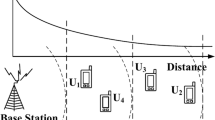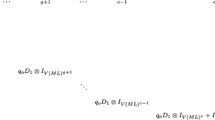Abstract
GERAN (GSM-EDGE Radio Access Network) operators have traditionally used the Erlang B formula to estimate the number of signalling channels on a per-cell basis. Thus, it is assumed that the network behaves as a loss system with Poisson arrivals. However, the presence of automatic retrial mechanisms and correlated arrivals in these channels suggests that these assumptions might not be valid. This paper presents a performance analysis of the Stand-alone Dedicated Control CHannel in GERAN. Preliminary analysis shows that the Erlang B formula underestimates congestion and blocking on this channel. To address this issue, a queueing model with retrials and correlated arrivals is proposed, where correlation between arrivals is modelled by a simple Markov-Modulated Poisson Process. The proposed model can be tuned on a per-cell basis by statistics in the Network Management System. Model assessment is based on performance statistics from a live GERAN system. Results show that a simple retrial queueing model fails to explain blocking in cells with a large number of channels. These limitations are overcome by adding correlated arrivals in the retrial model.
Similar content being viewed by others
Abbreviations
- BH:
-
Busy Hour
- BR:
-
Blocking Ratio
- CR:
-
Congestion Ratio
- EC:
-
Emergency Call
- GERAN:
-
GSM-EDGE Radio Access Network
- GH:
-
Ghost Seizure
- ID:
-
IMSI Detach
- LU:
-
Location Update
- MOC:
-
Mobile Originated Call
- MTC:
-
Mobile Terminated Call
- NMS:
-
Network Management System
- RE:
-
Call Re-Establishment
- RM:
-
Retrial Model
- RMCA:
-
Retrial Model with Correlated Arrivals
- SMS:
-
Short Message Service
- SS:
-
Supplementary Service
- SDCCH:
-
Stand-alone Dedicated Control CHannel
- TCH:
-
Traffic CHannel
References
Mouly, M., & Pautet, M. B. (1992). The GSM system for mobile communications. Cell & Sys.
Halonen T., Melero J., Romero J. (2002) GSM, GPRS and EDGE performance: Evolution toward 3G/UMTS. Wiley, London
Tunnicliffe, G., Murch, A., Sathyendran, A., & Smith, P. (1998). Analysis of traffic distribution in cellular networks. In Proceedings of 48th IEEE Vehicular Technology Conference (vol. 3, pp. 1984–1988).
Onur E., Delic H., Ersoy C., Caglayan M. U. (2002) Measurement-based replanning of cell capacities in GSM networks. Computer Networks 39(6): 749–767
Hong D., Rappaport S. S. (1986) Traffic model and performance analysis for cellular mobile radio telephone systems with prioritized and nonprioritized handoff procedures. IEEE Transactions on Vehicular Technology 35(3): 77–92
Fang Y., Chlamtac I. (1999) Teletraffic analysis and mobility modeling of PCS networks. IEEE Transactions on Communications 47(7): 1062–1071
Rappaport, S. (1990). The multiple-call hand-off problem in high-capacity cellular communications systems. In Proceedings of 40th IEEE Vehicular Technology Conference (pp. 287–294).
Li W., Alfa A. S. (1999) A PCS network with correlated arrival process and splitted-rating channels. IEEE Journal on Selected Areas in Communications 17(7): 1318–1325
Tran-Gia P., Mandjes M. (1997) Modeling of customer retrial phenomenon in cellular mobile networks. IEEE Journal on Selected Areas in Communications 15(8): 1406–1414
Marsan M. A., Carolis G. D., Leonardi E., Cigno R. L., Meo M. (2001) Efficient estimation of call blocking probabilities in cellular mobile telephony networks with customer retrials. IEEE Journal on Selected Areas in Communications 19: 332–346
Rappaport, S. (1993). Traffic performance of cellular communication systems with heterogeneous call and platform types. In Conference Record, 2nd International Conference on Universal Personal Communications (vol. 2, pp. 690–695).
Fang Y. (2003) Thinning schemes for call admission control in wireless networks. IEEE Transactions on Computers 52(5): 685–687
Lagrange, X., & Godlewski, P. (1995). Teletraffic analysis of a hierarchical cellular network. In Proceedings of 45th IEEE Vehicular Technology Conference (vol. 2, pp. 882–886).
Fitzpatrick P., Lee C. S., Warfield B. (1997) Teletraffic performance of mobile radio networks with hierarchical cells and overflow. IEEE Journal on Selected Areas in Communications 15(8): 1549–1557
Alfa A. S., Li W. (2002) PCS networks with correlated arrival process and retrial phenomenon. IEEE Transactions on Wireless Communications 1(4): 630–637
Artalejo J. R., Gómez-Corral A. (2008) Retrial queueing systems. Springer, Berlin
Macfadyen, N. W. (1979). Statistical observation of repeated attempts in the arrival process. In Proceedings of 9th International Teletraffic Congress (ITC).
Liu K. (1980) Direct distance dialing: Call completion and customer retrial behavior. Bell System Technical Journal 59: 295–311
Nesenbergs M. (1979) A hybrid of Erlang B and C formulas and its applications. IEEE Transactions on Communications 27: 59–68
Neuts M., Rao B. M. (1990) Numerical investigation of a multiserver retrial model. Queueing Systems 7(2): 169–189
Artalejo J., Pozo M. (2002) Numerical calculation of the stationary distribution of the main multiserver retrial queue. Annals of Operations Research 116: 41–56
Domenech-Benlloch, M., Giménez-Guzmán, J., Pla, V., Martínez-Bauset, J., & Casares-Giner, V. (2008). Generalized truncated methods for an efficient solution of retrial systems. Mathematical Problems in Engineering.
Chakravarthy S. R., Krishnamoorthy A., Joshua V. C. (2006) Analysis of a multi-server retrial queue with search of customers from the orbit. Performance Evaluation 63(8): 776–798
Domenech-Benlloch M., Giménez-Guzmán J., Martínez-Bauset J., Casares-Giner V. (2005) Efficient and accurate methodology for solving multiserver retrial systems. IEE Electronics Letters 41(17): 967–969
Giménez-Guzmán, J., Domenech-Benlloch, M., Pla, V., Casares-Giner V., & Martínez-Bauset J. (2007). Analysis of cellular network with user redials and automatic handover retrials. Lecture Notes in Computer Science, Next Generation Teletraffic and Wired/Wireless Advanced Networking 4712/2007:210–222.
Gotzner, U., Gamst, A., & Rathgeber, R. (1998). Spatial traffic distribution in cellular networks. In Proceedings of 48th IEEE Vehicular Technology Conference (vol. 2, pp. 1994–1998).
Almeida, S., Queijo, J., & Correia, L. (1999). Spatial and temporal traffic distribution models for GSM. In Proceedings of 50th IEEE Vehicular Technology Conference (vol. 1, pp. 131–135).
3GPP TS 05.02 (v6.6.0), Multiplexing and multiple access on the radio path; GSM-Phase2+, Release 97 (Nov, 1999).
3GPP TS 04.08 (v7.20.1), Mobile radio interface layer 3 specification; GSM-Phase2+, Release 98 (Sep, 2003).
Pedraza, S., Wille, V., Toril, M., Ferrer, R., & Escobar, J. (2003). Dimensioning of signaling capacity on a cell basis in GSM/GPRS. In Proceedings of 54th IEEE Vehicular Technology Conference (vol. 1, pp. 155–159).
Wilkinson R. (1956) Theories for toll traffic engineering in the USA. Bell System Technical Journal 35(2): 421–514
Stewart W. J. (1994) Introduction to the numerical solution of Markov chains. Princeton University Press, Princeton
Meier-Hellstern K., Fischer W. (1992) The Markov-modulated poisson process (MMPP) cookbook. Performance Evaluation 18: 149–171
Gaver D., Jacobs P., Latouche G. (1984) Finite birth-and-death models in randomly changing environments. Advances in Applied Probability 16(4): 715–731
Grassmann W., Taksar M., Heyman D. (1985) Regenerative analysis and steady state distributions for markov chains. Operations Research 33: 1107–1116
Servi L. D. (2002) Algorithmic solutions to two-dimensional birth-death processes with application to capacity planning. Telecommunications Systems 21(2–4): 205–212
Burden R. L., Faires D. J. (2004) Numerical Analysis. Brooks Cole, California
Nocedal J., Wright S. J. (2006) Numerical optimization (2nd ed.). Springer, Berlin
The MathWorks (2008). Optimization toolbox 4, user’s guide.
Gross D., Harris C. M. (1998) Fundamentals of queueing theory (3rd ed.). Wiley, London
Andreadis A., Benelli G., Giambene G., Marzucchi B. (2001) Analysis of the WAP protocol over SMS in GSM networks. Wireless Communications and Mobile Computing 1: 381–395
Holma H., Toskala A. (2004) WCDMA for UMTS: Radio access for third generation mobile communications (3rd ed.). Wiley, London
Holma H., Toskala A. (2009) LTE for UMTS. OFDMA and SC-FDMA based radio access. Wiley, London
Staehle, D., & Mäder, A. (2003). An analytic approximation of the uplink capacity in a UMTS network with heterogeneous traffic. In Proceedings of 18th International Teletraffic Congress (ITC) (pp. 81–91).
Iversen, V., Benetis, V., Ha, N., Ha, V., & Stepanov, S. (2004). Evaluation of multi-service CDMA networks with soft blocking. In Proceedings of 16th International Teletraffic Congress (ITC) (pp. 212–216).
Wang, H., & Iversen, V. (2008). Erlang capacity of multi-class TDMA systems with adaptive modulation and coding. In Proceedings of IEEE International Conference on Communications (ICC) (pp. 115–119).
3GPP TS 23.012 (v8.2.0), Technical specification group core network; Location management procedures, Release 8 (June, 2009).
Author information
Authors and Affiliations
Corresponding author
Rights and permissions
About this article
Cite this article
Luna-Ramírez, S., Toril, M. & Wille, V. Performance Analysis of Dedicated Signalling Channels in GERAN by Retrial Queues. Wireless Pers Commun 60, 215–235 (2011). https://doi.org/10.1007/s11277-010-9939-1
Published:
Issue Date:
DOI: https://doi.org/10.1007/s11277-010-9939-1




